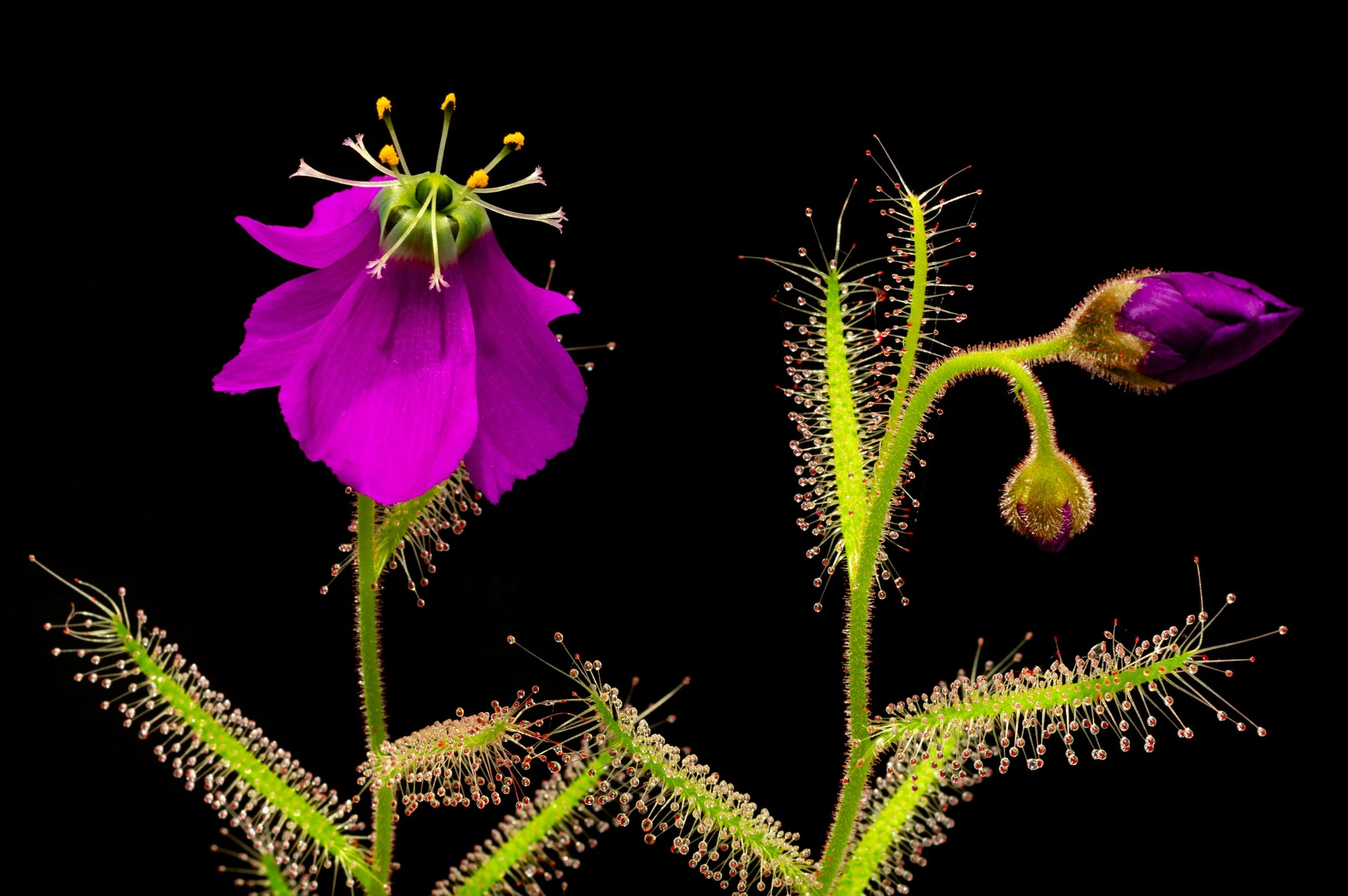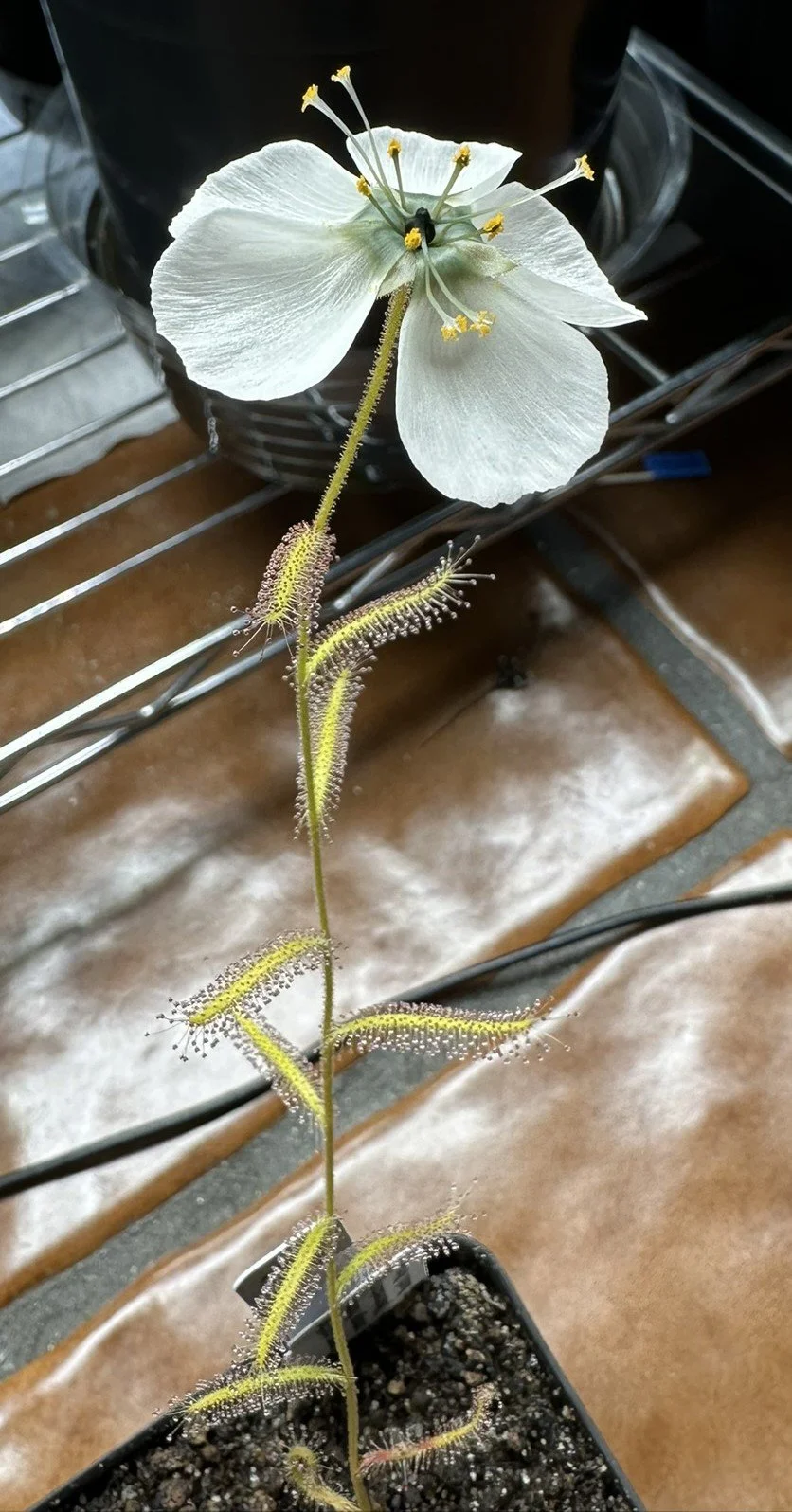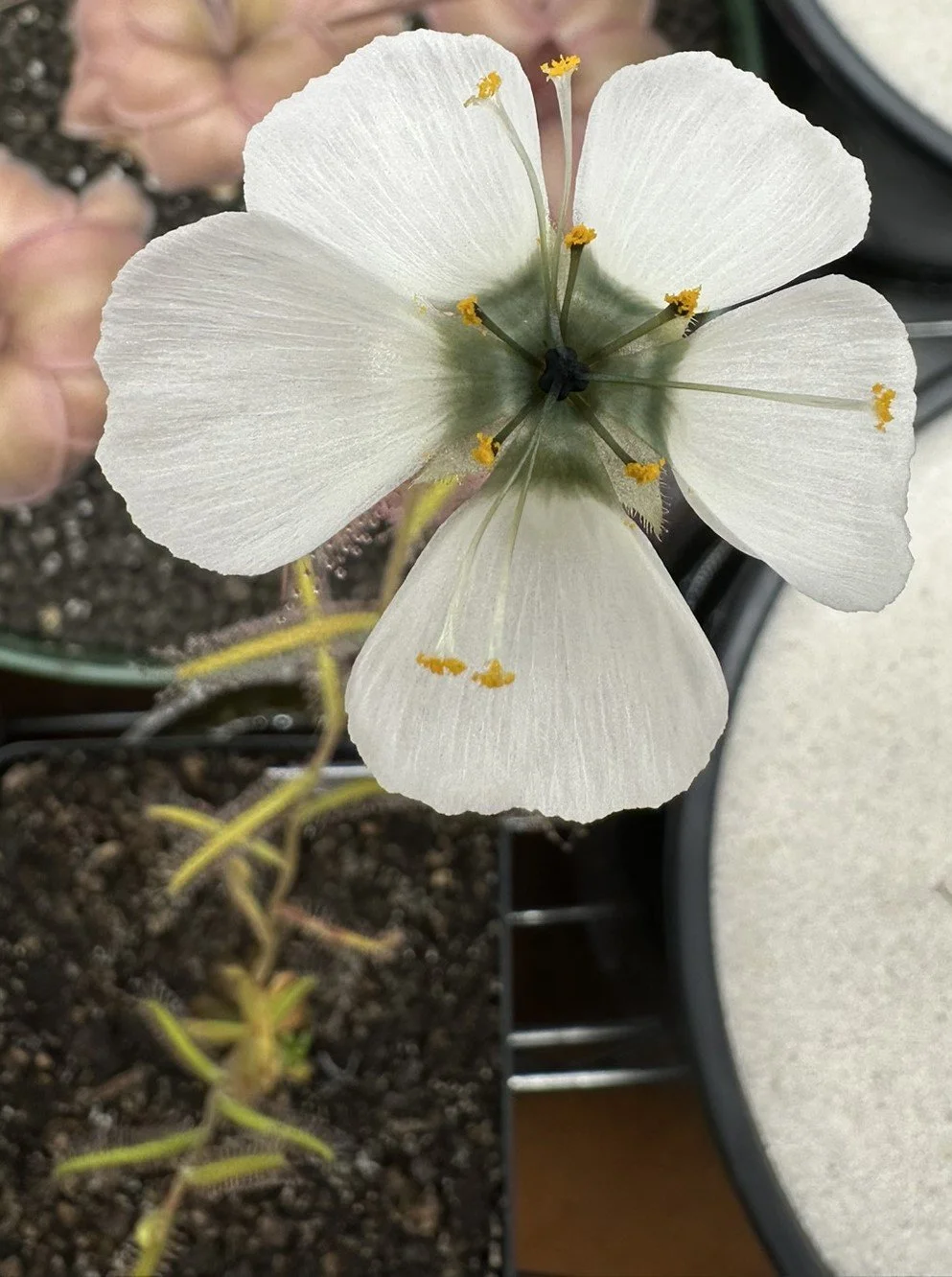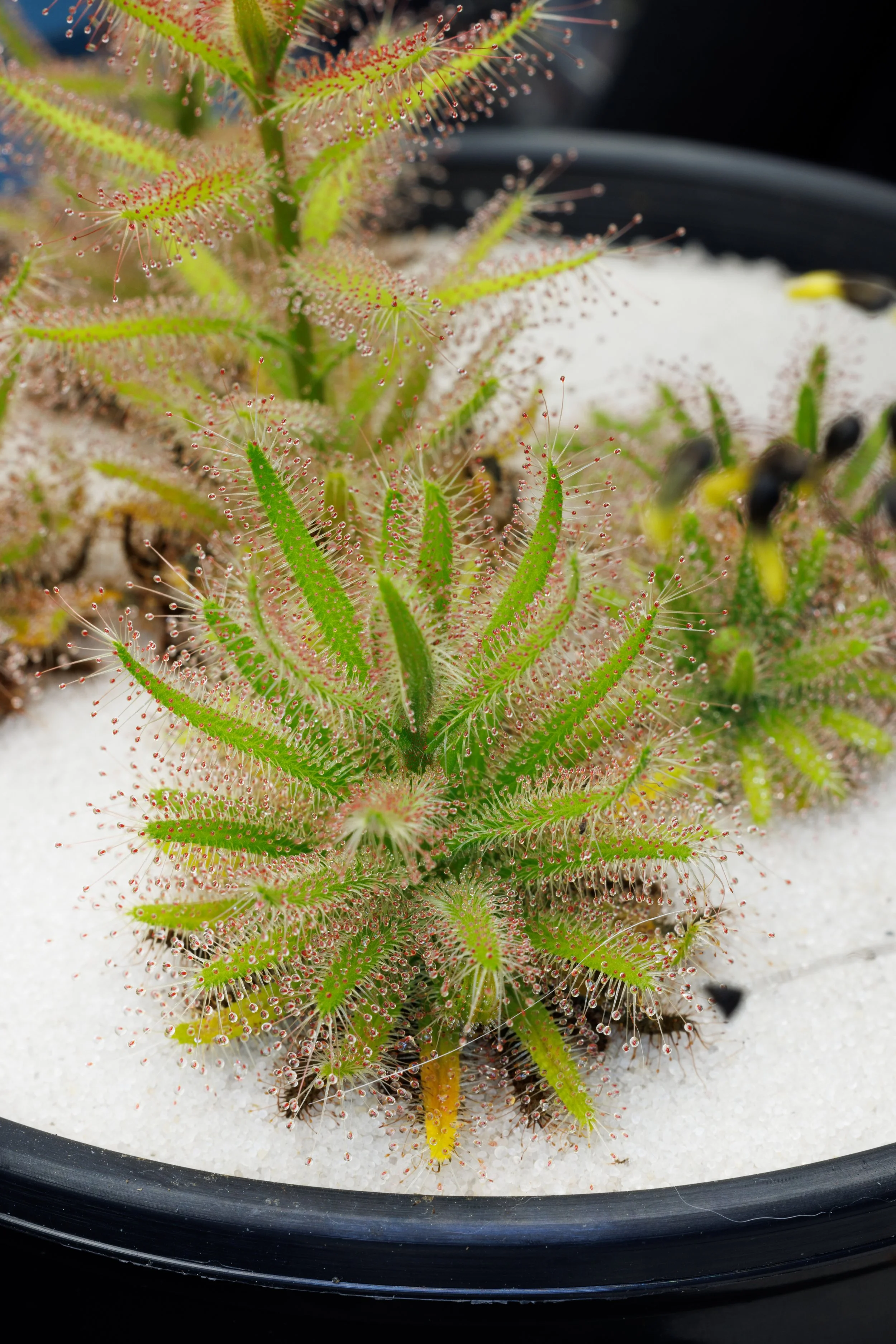Winter-Growing Sundew (Drosera) Cultivation







General Info:
Winter-Growing Sundews are a unique group of Drosera, native to the Cape Provinces of South Africa, that grow during the cool, wet winters and go dormant during the hot, dry summers. While Tuberous Sundews (Native to Australia and New Zealand) are winter-growing as well, they have their own separate page found here: Tuberous Sundews. The South African Winter-Growing Sundews typically have linear, strap-shaped leaves, but their flowers can be spectacular, huge, and the most beautiful of all Sundews. The many forms of Drosera cistiflora can have 2-2.5” diameter flowers ranging in color from red, orange, yellow, white, lavender, cerise, purple, pink, cream, and more. These are challenging to grow and require patience to achieve success, but blooming a Drosera cistiflora is one of the great joys of growing Sundews.
In their native habitats, these Sundews have evolved to go dormant in the summer when the soil moistly dries out. Using a fleshy, vertical root to store energy and water, all of the leaves die off to survive as this root underground until the next winter. Given the diversity of habitats and species, some species have strict summer dormancies, while others seem to be more optional in dormancy, responding to the specific conditions. For species with required dormancy like Drosera cistiflora, the soil must be allowed to dry out (maintaining some residual moisture) for several months. Other species seem to have optional dormancy and will continue growing if kept wet.
Cultivation of Winter-Growing Sundews is an incredibly nuanced sub-hobby of carnivorous plant growing (often grouped together with Tuberous Sundews). Most growers focus on these species after succeeding at growing most other species of Sundew. While being proficient at growing Winter-Growing/Tuberous Sundews can take many years (or decades), getting started can be approachable for any grower that has successfully grown a diversity of Sundews. The basic principles are as follows:
Winter growing season must be moist, cool, and reasonably bright. Overly hot temperatures can cause early dormancy which can be fatal if dormant roots were not sufficiently produced. Proper photoperiod is necessary if growing under lights.
Summer dormancy is obligatory in some species and plants must go dormant to survive. The dormant roots need time and conditions to form properly at the end of the growing season and should be stored mostly dry, but with some residual moisture.
Plants must have adequate nutrition to accumulate energy in the short growing season. Feeding is required.
Starting in around October, light watering can be reintroduced to the pots. Some species will come up without much moisture and when growth is visible at the surface, regular watering should resume for the season. I find that these South African Winter-Growers generally come out of dormancy later than Tuberous Sundews, some as late as January. Like Tuberous Sundews, they prefer well-draining soils that avoid soggy conditions which can rot the roots. Towards the end of the growing season around May-June, many species will naturally turn brown and die back to the roots. Some require the complete cessation of watering to allow the gradual drying of the soil which eventually induces dormancy. Unlike Tuberous Sundews, I find that the roots of these species are more sensitive to dessication during dormancy and should be kept more moist.
Species: Drosera cistiflora, Drosera trinervia, Drosera afra, Drosera acaulis, Drosera variegata, Drosera liniflora, Drosera pauciflora, Drosera zeyheri
Seed Germination
Germinating seeds of South African Winter-Growers is in general much easier than Tuberous Sundews. Many species do not require any special treatment. Some however, are quite resistant to germination and may require a heat treatment to simulate the summer season. Species like Drosera trinervia do not seem to require any treatment and readily germinate. Some forms of Drosera cistiflora readily germinate as well, while others are very difficult.
To sow, seeds can be sprinkled onto the surface of moist media. I find slightly better germination with added humidity, however good airflow is still necessary to prevent fungus and rot. Plants should be fed early which will substantially accelerate growth (though overfeeding can cause death). I typically find slow growth in the first season when plants may be diverting more energy to root production than to vegetative growth (likely to help survival through the first difficult summer dormancy). These roots can be very small and difficult to find the soil, so I typically leave them in their same pots until at least year 2 to avoid loss or damage during a repot.
Cultivation:
Lighting: Part to Full Sun or at least 15W per sq ft LED light. Winter-Growing Sundews like strong light, though do not require as much as other species due to their native winter sun levels.
Water: Distilled or Reverse Osmosis water. Sitting in 0.5”-1” of water using the tray method depending on pot height during active growth. Winter-Growing Sundews prefer very good drainage and do not want soggy conditions like other sundews. Watering must be tapered down as they approach dormancy to ensure proper root formation.
Climate: Temperatures from 40-75F with good airflow during the growing season. High temperatures can cause premature dormancy. Dormancy must be allowed or induced by mostly drying out the soil around May and keeping it barely moist until ~October. Seasonal cues are strictly required, this is not optional!
Soil: In general, they can be grown in a 33% peat: 67% coarse sand (or perlite/sand mix). Deep pots are important to give space for the long roots and to manage moisture.
Feeding: Feed dewy leaves with Insect Powder or Insect Powder every 1-2 weeks or so.
Notes:
Different species can have slightly different dormancy requirements.
No one has the same growing conditions so specific cultivation methods will vary between growers.
Dormant roots should be fleshy and kept with a small amount of residual moisture.
More Information:
https://www.fierceflora.com/the-different-colours-of-drosera-cistiflora/